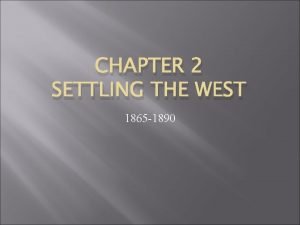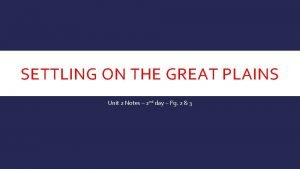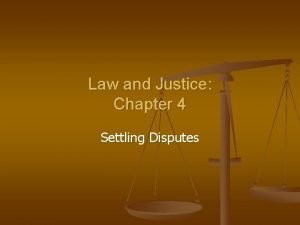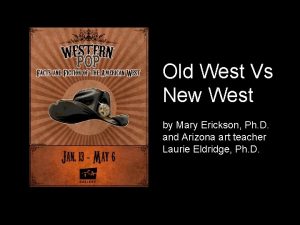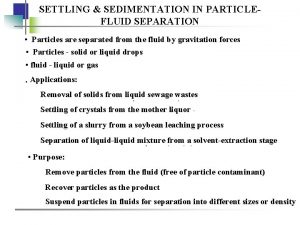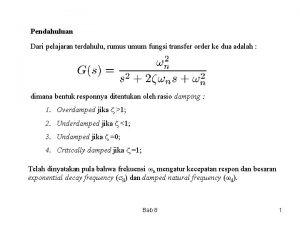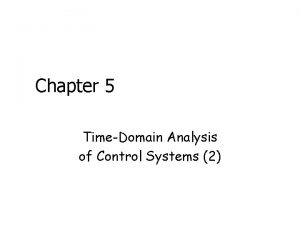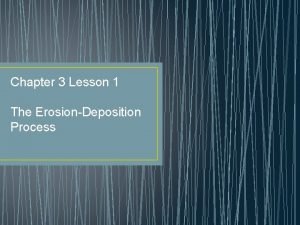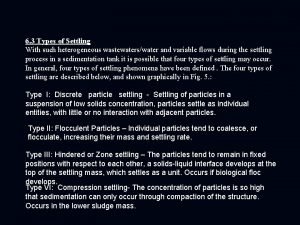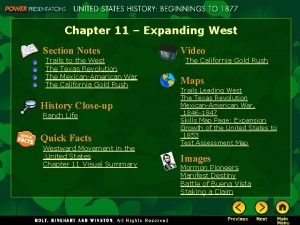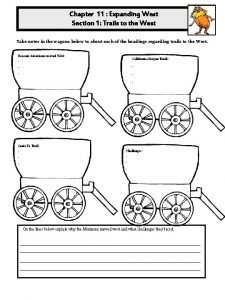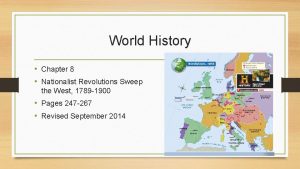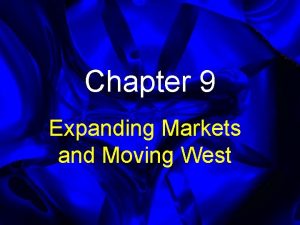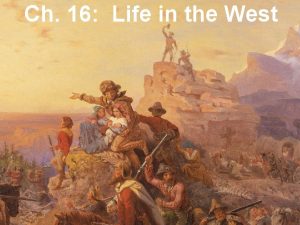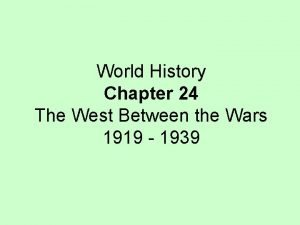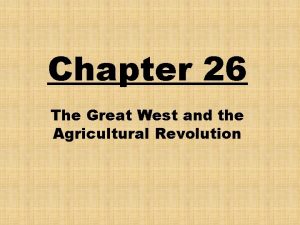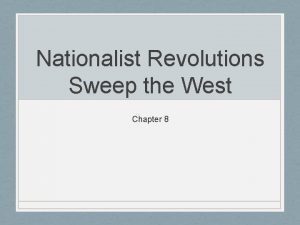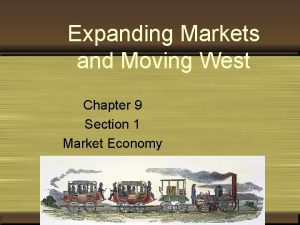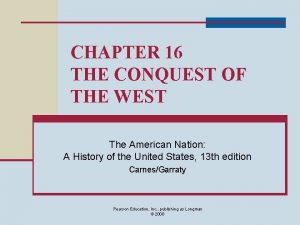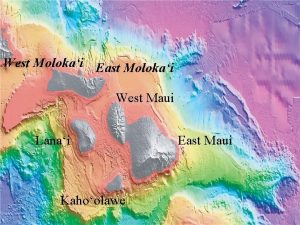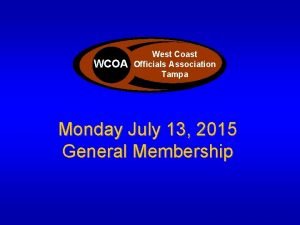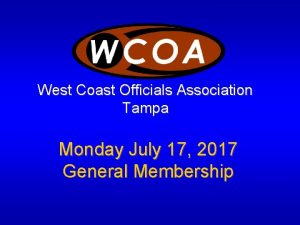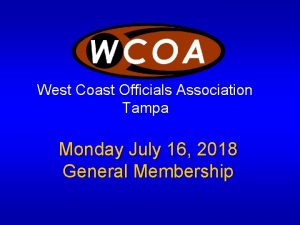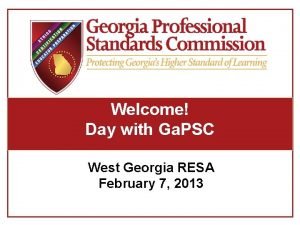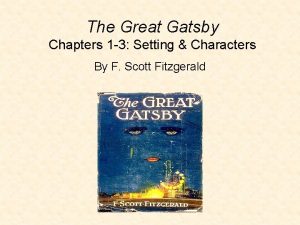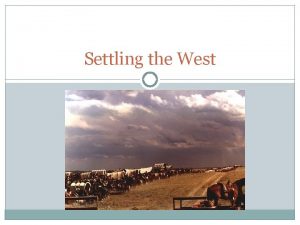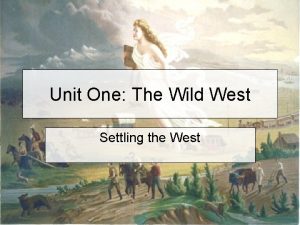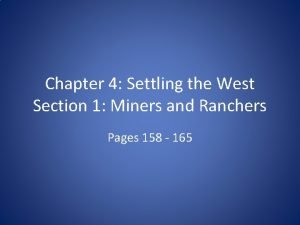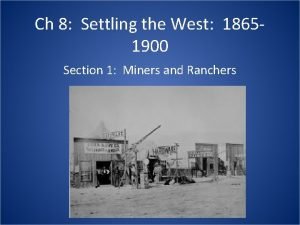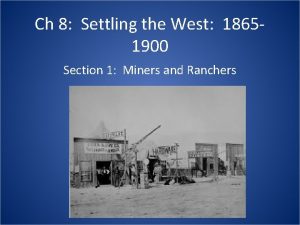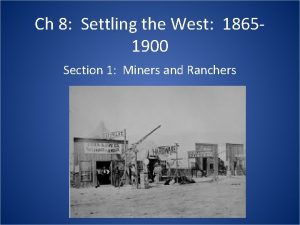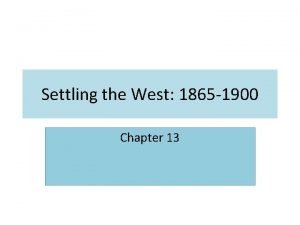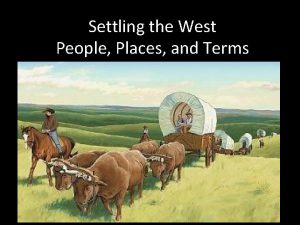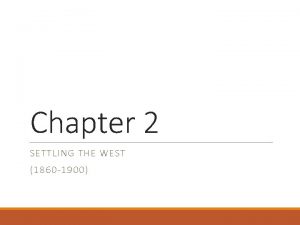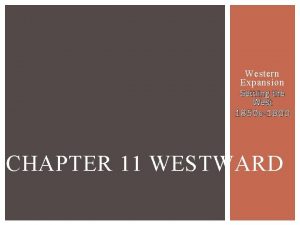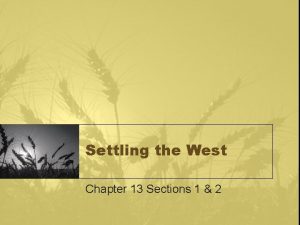Chapter Chapter 3 Section 1 Settling the West
































































































































- Slides: 128

Chapter

Chapter 3 Section 1 Settling the West

Growth of the Mining Industry • Some cattle ranches in the West were enormous, covering more land than Massachusetts and Vermont put together.

Growth of the Mining Industry • Growing industries in the East needed the West’s rich deposits of gold, silver, and copper. – Brought settlers to the West’s mountain states

Boom and Bust • 1859: Henry Comstock staked a claim for a silver mine in Virginia City, NV – went from an outpost to a boomtown overnight. – mines run out of silver • boomtown ghost town. – Cycle of boom and bust repeated throughout the mountainous West.

Growth of the Mining Industry • During boom times, crime = a serious problem. – Vigilance committees formed to track down and punish criminals.

Growth of the Mining Industry • Where was the mining industry? – Colorado, the Dakota Territory, and Montana. – Mining in Colorado spurred the building of railroads through the Rocky Mountains. • Denver = supply point for the mining areas • Denver = 2 nd largest city in the West after San Francisco.


Ranching & Farming the Plains • Where are the Great Plains? – extends westward to the Rocky Mountains from around the 100 th meridian—an imaginary line running north and south from the central Dakotas through western Texas

Map 16. 1 The Natural Environment of the West, 1860 s (p. 458) • As settlers pushed into the Great Plains & beyond the line of semiaridity, they sensed the overwhelming power of the natural environment. In a landscape without trees for fences and barns and without adequate rainfall, ranchers and farmers had to relearn their business. The Native Americans peopling the plains and mountains had in time learned to live in this environment, but this knowledge counted for little against the ruthless pressure of the settlers to domesticate the West.

Ranching & Farming the Plains • Post-Civil War – many Americans began building large cattle ranches on the Great Plains. – Texas longhorn = a breed of cattle that could survive the harsh climate of the plains.

Ranching & Farming the Plains • Cattle ranching industry grows, why? – because of the open range = vast areas of grasslands owned by the federal government – Cattle raisers could graze their herds free of charge & without boundaries.

Ranching & Farming the Plains • During the Civil War: – large #s of eastern cattle were slaughtered to feed the Union and Confederate armies • After the war – beef prices soared, so? • This made it worthwhile to round up the longhorns.

Ranching & Farming the Plains • Long Drive: (first one in 1866) – across the Great Plains to the railroad in Sedalia, Missouri, – proved that cattle could be driven north to the rail lines and sold for 10 times the price they could get in Texas.

Cowboys on the Open Range • In open-range ranching, cattle from different ranches grazed together. AT the roundup, cowboys separated the cattle by owner and branded the calves. Cowboys celebrated in dime novels were really farmhands on horseback, with the skills to work on the range. An ethnically diverse group, including blacks and Hispanics, they earned $25. 00 a month, plus meals & a bed in the bunkhouse, in return for long hours of grueling, lonesome work.

Ranching & Farming the Plains • Railroads – provided easy access to the Great Plains. – Railroad companies sold land along the rail lines at low prices and provided credit.

Ranching & Farming the Plains • Homestead Act (1862) – For $10, a settler could file for a homestead • = a tract of public land available for settlement. • 160 acres of public land • could receive title of it after living there 5 years.

Ranching & Farming the Plains • Difficult Plains life: – environment = harsh, – summer temperatures over 100°F – winter = blizzards & extreme cold. – Prairie fires and swarms of grasshoppers were a danger & a threat.

Ranching & Farming the Plains • New Technology (1860 s) – newly designed steel plows – seed drills – Reapers – threshing machines. • machines made dry farming possible. • could work large tracts of land with the machines.

Ranching & Farming the Plains • Wheat – withstood drought better than other crops • became = most important crop on the Great Plains. – Wheat farmers from Minnesota & other Midwestern states moved to the Great Plains • take advantage of the inexpensive land & the new farming technology. – Wheat Belt • began at the eastern edge of the Great Plains and included much of the Dakotas and the western parts of Nebraska and Kansas.

Ranching & Farming the Plains • Events causing Great Plains farmers to fall on hard times: – In the 1890 s, a glut of wheat caused prices to drop. – Some farmers lost their land because they could not repay bank loans they had taken out. – prolonged drought that began in the 1880 s forced many farmers to return to the East.

Native Americans • How did they live? – Some GP Nat. Ams. lived in communities and farmed and hunted. – Most GP Nat. Ams were nomads who moved from place to place in search of food. • followed the herds of buffalo.

Native Americans • GP Nat. Ams had several things in common: – lived in extended family networks – had a close relationship with nature – were divided into bands with a governing council – practiced a religion based on a belief in the spiritual power of the natural world.

Native Americans • White settlement pressure (encroaching on their lands): – 1862 the Sioux in Minnesota launched a major uprising.

Native Americans • 1867 Congress formed an Indian Peace Commission – proposed creating two large reservations on the Plains. – Bureau of Indian Affairs would run the reservations. – U. S. army would deal with any groups that did not report to or remain on the reservations. • This plan was doomed to failure – Signing treaties did not ensure that the govt or Native Americans would abide by their terms.

Native Americans • 1870 s: buffalo were rapidly disappearing. • 1889 very few buffalo remained. – buffalo were killed by migrants crossing the Great Plains – professional buffalo hunters wanted their hides, – sharpshooters hired by railroads, and hunters who killed them for sport.

Native Americans • Many Nat. Ams. left their reservations to hunt buffalo on the open plains • Nat. Ams. Saw Americans violate treaties so they saw no reason to abide by them.

Native Americans • The Indians: – – lost their ancestral lands Faced an alien future of farming Were confronted by a winter of starvation At the same time, news of “salvation” came from a holy man called Wovoka • predicted the disappearance of the whites • Encouraged the Ghost Dance as a ritual to prepare for the regeneration.

Native Americans • Frenzy of Wovoka’s Ghost Dance swept through the Sioux encampments in 1890, – alarmed whites called for army intervention. • The bloody battle at Wounded Knee: – Erupted when soldiers attempted to disarm a group of Wovoka’s followers; – final episode in the long war of suppression of the Plains Indians. – Thereafter, the division of tribal lands proceeded without hindrance. • As whites flooded the newly acquired land, Indians became the minority.

The Dead at Wounded Knee (p. 472) • In December 1890 US soldiers massacred 146 Sioux men, women, and children in the Battle of Wounded Knee in south Dakota. It was the last big fight on the northern plains between the Indians and the whites. Black Elk, a Sioux holy man, related that “after the soldiers marched away from their dirty work, a heavy snow began to fall…and it grew very cold. ” The body of Yellow Bird lay frozen where it had fallen.

Native Americans • The Dawes Act of 1887 declared that land for the Indians would be allotted in 160 -acre lots to heads of households: – Then Indians would become U. S. citizens – Remaining reservations were sold off – Proceeds going toward Indian education. • 1890: – The federal government announced that it had tribal approval to open the Sioux “surplus” land to white settlement.

Map 16. 5 The Sioux Reservations in South Dakota, 1868 -1889 (p. 471) • In 1868, when they bent to the demand that they move onto the reservation, the Sioux thought they had gained secure rights to a substantial part of their ancestral hunting grounds. But as they learned to their sorrow, fixed boundary lines only increased their vulnerability to the land hungry whites and sped up the process of expropriation.

Native Americans • The Dawes Act was a failure. – Few Native Americans had the training or enthusiasm for farming or ranching. – allotments were too small to be profitable. – Few Native Americans were willing or able to adopt the American settlers’ lifestyles in place of their own culture.

• Alexander Graham Bell taught deaf children. He once told his family that he preferred to be remembered as a teacher rather than as the inventor of the telephone. Bell’s father, Alexander Melville Bell, taught deafmutes to speak and wrote textbooks on correct speech. As boys, Alexander Graham Bell and his brothers helped their father in public demonstrations of Visible Speech, a code of symbols that indicated what position of the throat, tongue, and lips were used in making sounds.

The United States Industrializes • End of Civil War: – American industry expanded – millions of people left their farms to work in mines & factories. • By the early 1900 s: – US becomes world’s leading industrial nation • By 1914: – gross national product (GNP)=total value of goods & services produced by a country • = 8 X greater than at the end of the Civil War.

The United States Industrializes • US natural resources = Water, timber, coal, iron, and copper – that leads US industrial success. – Transcontinental railroads increased industrialization • brought settlers and miners to the West • moved resources to the factories in the East.

The United States Industrializes • Petroleum Demand – could be turned into kerosene for lanterns & stoves – created the American oil industry. • 1859 – Edwin Drake drilled 1 st oil well near Titusville, Pennsylvania • oil production increased leads to economic expansion.

The United States Industrializes • Between 1860 and 1910 US population 3 xs – = a large workforce – = a greater demand for consumer goods. • Laissez-faire = a French phrase that means “let people do as they choose, ” – = a popular idea in the late 1800 s – Many Americans believed the govt, should not interfere with the economy – wanted supply & demand to regulate prices & wages.

The United States Industrializes • Entrepreneurs – risked their capital to organize & run a business – late 1800 s, they were attracted to manufacturing & transportation fields. – So? 100 s of factories & 1000 s of miles of railroad were built.

The United States Industrializes • late 1800 s, state & fed. govt had a laissez-faire attitude – kept taxes and spending low – Did not impose regulations on industry. – The govt did not control wages or prices. – adopted policies to help industry.

The United States Industrializes • high tariffs imposed by Congress in the mid 19 th c. , – contradicted laissez-faire policies & harmed many Americans. – US raises tariffs on foreign products • other countries respond by raising tariffs against Am. products. • American companies who sold goods overseas, esp. farmers, were hurt by high tariffs.

The United States Industrializes • Early 1900: – American industries = large & highly competitive. – Many business leaders began to encourage free trade • believed they could compete internationally & succeed. • New inventions increased America’s productivity – & produced wealth and job opportunities.

Kellogg’s Toasted Corn Flakes • Like crackers, sugar, and other nonperishable products, cereal had been traditionally sold to consumers in bulk from barrels. In the 1880 s the Quaker Oats Company hit on the idea of selling oatmeal in boxes of standard size and weight. A further wrinkle was to process the cereal so that it could be consumed right from the box (with milk) for breakfast. And lo and behold: Kellogg’s Corn Flakes! This is one of Kellogg’s earliest advertisements.

The United States Industrializes • 1876 Scottish-American inventor Alexander Graham Bell invented the telephone. – 1877 Bell organized the Bell Telephone Company – later becomes the American Telephone & Telegraph Company (AT&T).

The United States Industrializes • late 1800 s: Thomas Alva Edison invented or perfected: – – – the phonograph the light bulb the electric generator the dictaphone the mimeographthe motion picture. • In 1882 the Edison Electric Illuminating Co. became a new industry – began supplying electric power to customers in New York City.

Thomas Edison’s Laboratories in Menlo Park, New Jersey, c. 1880 Thomas Edison’s dream of illuminating the world is illustrated by this fanciful drawing of his laboratories in Menlo, New Jerse For the time being, however, it was the American home that was the primary beneficiary of Edison’s wonderful light bulb, since electricity was slow to arrive in many parts of the world.

The Railroads: Linking the Nation • Post- Civil War: – railroad construction dramatically expands – 1862 Lincoln signs the Pacific Railway Act • provides for the construction of a transcontinental railroad by the Union Pacific and Central Pacific railroad companies • May 10, 1869: – the first transcontinental railroad was complete.

The Expansion of the Railroad System, 1870 -1890 • In 1870 the nation had 53, 000 miles of rail track; in 1890 it had 167, 000 miles. That burst of construction essentially completed the nation’s rail network, although there would be additional expansion for the next two decades. The main areas of growth were in the South and west of the Mississippi. The Great Plains and the Far West accounted for over 40 percent of all railroad construction in this period.

The Railroads: Linking the Nation • Railroads – encouraged the growth of American industry. – linked the nation & increased the size of markets. – stimulated the economy by spending large amounts of money on steel, coal, and timber. • 1883 – rail service became safer & more reliable • the American Railway Association divided the country into four time zones, or regions, where the same time was kept.

The Railroads: Linking the Nation • Large integrated railroad systems: – provided increased efficiency – decrease in time spent in long distance travel – it united Americans from different regions. • Land grants – given to railroad companies by the federal government to encourage railroad construction • Railroad companies (like the Union Pacific and Central Pacific) – were able to cover all their building costs by selling the land to settlers, real estate agencies, and other businesses.

The Railroads: Linking the Nation • Wealth of railroad entrepreneurs = accusations that they had acquired their wealth through illegal means • Bribery occurred frequently in this era.

The Railroads: Linking the Nation • Not all railroad entrepreneurs were corrupt. – James J. Hill built the Great Northern Railroad • without any federal land grants or subsidies • = the most successful transcontinental railroad & the only one not to go bankrupt.

The Rise of Big Business • By 1900 big business dominated the economy of the US • corporation = – an organization owned by many people but treated by law as though it was a single person – Stockholders, • = people who own the corporation (own shares of ownership called stock) • Issuing stock allows a corporation to raise large sums of $ & spreads out the financial risk.

The Rise of Big Business • When corporations sell stock they invest in new technologies – to increase their efficiency. • Advantages of big corporations: – produce more cheaply – could continue to operate even in poor economic times by cutting prices to increase sales. • Many small businesses with high operating costs were forced out of business.

The Rise of Big Business • vertical integration (a way of structuring a corporation) – vertically integrated companies own all the different businesses it depends on for its operation. – This not only saved money but also made the big company bigger. – Andrew Carnegie, a Scottish immigrant, began of the steel industry as a vertically integrated corporation • horizontal integration – Business leaders also pushed for this, combining many firms doing the same type of business into one large corporation.

The Rise of Big Business

The Rise of Big Business • monopoly = when one company gains control of an entire market. – In the late 19 C, Americans became suspicious of large corporations & feared monopolies. – Many states made it illegal for a company to own stock in another company without permission from the state legislature. • 1882 Standard Oil formed the first trust – merged businesses without violating laws against owning other companies. – Trusts allow a person to manage another person’s property. – A holding company did not produce anything itself • Instead, it owned the stock of companies that did produce goods. • holding companies controlled all the companies it owned, merging them all into one large enterprise.

Unions • Workers in industrial America: – faced monotonous work – dangerous working conditions – an uneven division of income between the wealthy and the working class. – felt the only way to improve their working environment was to organize unions • Marxism = the ideas of Karl Marx, was popular in Europe. – The class struggle between the workers & the owners shaped society – believed the workers would revolt & gain control. – After the revolution, a socialist society would be created where wealth was evenly divided, & classes would no longer exist.

Unions • As ideas of Marxism spread in Europe, tens of thousands of immigrants arrived in the US. • People began to associate Marxism with immigrants. • They became suspicious of unions as well.

Unions • industrial unions: united all craft workers and common laborers in a particular industry. • Employers opposed unions – went to great lengths to prevent unions from forming. – would have workers take oaths or sign contracts promising not to join a union. – Would hire detectives to identify union organizers.

Unions • Workers attempted to create large unions – rarely succeeded. – Many times confrontations between owners and government ended in violence. • If a union was formed, companies used a lockout to break it. – Workers went without pay and were locked out of the property – If the union did strike, employers would hire replacement workers called strikebreakers. • Workers who organized a union or strike were fired – put on a blacklist—a list of troublemakers. – Once blacklisted, a worker could get a job only by changing trade, residence, or his or her name.

Unions • American Federation of Labor (AFL): – In 1886 delegates from over 20 of the nation’s trade unions organized the AFL » The AFL’s first leader was Samuel Gompers, » His plain and simple approach to labor relations helped unions become accepted. » Gompers wanted to keep unions out of politics and to fight for small gains such as higher wages and better working conditions.

Unions • Under Gompers’s leadership, the AFL had three goals: 1. to get companies to recognize unions & agree to collective bargaining 2. to push for closed shops, where companies could only hire union members 3. to promote an eight-hour workday. • By 1900 the AFL had over 500, 000 members. – The majority of workers, however, were still unorganized.

Unions • By 1900 women made up more than 18% of the labor force. Women worked as: – – – domestic servants Teachers Nurses sales clerks secretaries • Women were paid less than men. – It was felt that men needed a higher wage because they needed to support a family – Most unions excluded women.

Immigration & Urbanization Chapter 3, Section 3

Mulberry Street, New York City, c. 1900 (p. 543) • The influx of southern and Eastern Europeans created teeming ghettos in the heart of New York City and other major American cities. The view is of Mulberry Street, with its pushcarts, street peddlers, and bustling traffic. The inhabitants are mostly Italians and some of them, noticing the photographer preparing his camera, have gathered to be in the picture.

Immigration • By 1900: – Eastern & Southern Europeans made up more than ½ of all immigrants – 14 million arrived b/w 1860 -1900 • Many were European Jews – America offered • Immigrants employment • Few immigration restrictions • Avoidance of military service • Religious freedom • Chance to move up social ladder

• Travel: Immigration – Steerage • Most immigrants took the difficult trip to America in steerage • the least expensive accommodations on a steamship – 14 -day trip usually ended at Ellis Island • small island in NY Harbor • served as a processing center for most immigrants arriving on the East Coast after 1892 • Most immigrants passed through Ellis Island in a day • some faced the possibility of being separated from family and possibly sent back to Europe due to health problems.

Ellis Island Pictures

Immigration • Most immigrants settled in cities – Lived in ethnically separated neighborhoods – They duplicated many of the comforts of their homelands – including language and religion • Learning English – Allowed immigrants to adapt to American culture – Gave them marketable skills • Settling among members of their own ethnic – Allowed immigrants to adjust well to living in the US

Immigration • Chinese Immigrants – Came to America because… • Severe unemployment, poverty, and famine in China; • Discovery of gold in California • Taiping Rebellion in China • Demand for railroad workers in the US led to an increase in Chinese immigration to the US in the mid-1800 s.

Immigration • Chinese Immigrants (mainly Western Cities) – worked as laborers, servants, skilled tradesmen, and merchants – Some opened their own laundries.

Immigration • Japanese immigration – 1900 -1908: Japanese immigration to the US drastically increased as Japan began to build an industrial economy and an empire. • Angel Island: – routinely the first stop for immigrants crossing the Pacific Ocean – In 1910 a barracks was opened on Angel Island in California. • Asian immigrants, mostly young men and boys, waited sometimes for months for the results of immigration hearings

Angel Island Images

Immigration • Nativism: preference for native-born people & a desire to limit immigration. Earlier, in the 1840 s and 1850 s – The increase in immigration led to nativism – nativism was directed towards the Irish – In the early 1900 s, it was the Asian, Jews, and eastern Europeans that were the focus of nativism.

Immigration • Nativism led to the forming of 2 antiimmigrant groups. – The American Protective Association (est. 1887) • The party’s founder, Henry Bowers, disliked Catholicism. • wanted to stop Catholic immigration. In the 1870 s, – Workingman’s Party of California : • Denis Kearny, an Irish immigrant, organized this group… wanted to stop Chinese immigration. Racial violence resulted.

Discussion Question • Why did nativists oppose eastern European immigrants? – Nativists thought the large influx of Catholic immigrants from Ireland would give the Catholic Church too much power in the American government. Labor unions feared that immigrants would work for lower wages and take work as strikebreakers.

Urbanization • Urban population of the US grew – from about 10 million in 1870 – to over 30 million by 1900. • Immigrants remained in the cities – where they worked long hours for little pay. – most immigrants felt their standard of living had improved in the US

Map 19. 1 America’s Cities, 1900 (p. 545) • The number of Americans living in urban places more than doubled between 1880 & 1900, with the most dramatic increases in the largest metropolitan centers, New York grew from 1. 2 million to 3. 4 million, Chicago from 500, 000 to 1. 7 million

Urbanization • Housing and transportation needs changed – due to the increase in the amount of people living in cities. • As the price of land increased, building owners began to build up. – Created skyscrapers, tall steel frame buildings

Urbanization • Transportation in the late 1800 s – various kinds of mass transit developed to move large numbers of people around cities quickly – Began with the horsecar – Later to the more sophisticated electric trolley cars and elevated railroads – Engineers created ways to move the everexpanding population around the city.

Map 19. 2 The Expansion of Chicago, 1865– 1902 (p. 547) • In 1865 Chicagoans depended on horsecar lines to get around town. By 1900 the city limits had expanded enormously, accompanied by an equally dramatic expansion of streetcar service, which was by the electrified. Elevated trains also helped to ease congestion in the urban core. New streetcar lines, some extending beyond the city limits, were important to suburban development in the coming years.

Urbanization • Housing: – Definite boundaries could be seen between where the wealthy, middle class, and working class people lived. – Wealthy families lived in the heart of the city where they constructed elaborate homes. – The middle class, which included doctors, lawyers, engineers, and teachers, tended to live away from the city. – Majority of urban dwellers were part of the working class who lived in city tenements, or dark and crowded multifamily apartments.

Figure 19. 1 Floor Plan of a Dumbbell Tenement (p. 549) In a contest for a design that met an 1879 requirement that every room have a window, the dumbbell tenement won. The interior indentation, which created an airshaft between adjoining buildings, gave the tenement its “dumbbell” shape. What was touted as a “model” tenement demonstrated instead the futility of trying to reconcile maximum land usage with decent housing. Each floor contained four apartments of three or 4 rooms. The largest only 10 by 11 ft. The 2 toilets in the hall became filthy o broke down under daily use by forty or more people.

Urbanization • Problems with urban growth – An increase in crime, fire, disease, and pollution. • Alcohol contributed to crime – 1880 -1900 • large increase in the murder rate – Contaminated drinking water from improper sewage disposal • resulted in epidemics of typhoid fever and cholera • Native-born Americans blamed the problems on immigrants

Urbanization • Political Machine: – A new political system to deal with urban problems – Informal political group designed to gain and keep power – provided essentials to city dwellers in exchange for votes – Party bosses ran the machines

Urbanization • Party bosses: – had tight control of the city’s money – Many of the politicians became wealthy due to fraud or graft—getting money through dishonest or questionable means. • Most famous New York Democratic political machine was Tammany Hall – 1860 s and 1870 s, Tammany Hall’s boss was William M. Tweed. – Tweed’s corruption sent him to prison in 1874.

Urbanization • Opponents of political machines – blasted bosses for their corruption – Example: Cartoonist, Thomas Nast • Defenders of political machines – thought machines supplied necessary services – and helped to assimilate the masses of new city dwellers

Discussion question • What were some of the problems caused by political machines? – The bosses that ran the political machines grew rich by accepting bribes, selling permits to friends, and dealing in other corrupt ways to benefit themselves

The National Pastime (p. 568) In 1897, as today, the end-of-season games filled the bleachers. Here the Boston Beaneaters are playing the Baltimore Orioles. Boston won. The Baltimore stadium would soon be replaced by a bigger concrete and steel structure, but what is happening on the fields need no updating. The scene is virtually identical to today’s game.

Early Reforms in the Gilded Age Chapter 3, Section 4

Warm-up • Artist Thomas Eakins was part of the movement known as realism. His painting The Gross Clinic was rejected for an exhibition in Philadelphia because it was considered too harshly realistic. What about the painting might have caused this reaction? A. B. C. D. The features of the people are not clear. The medical students are dissecting human body parts. The colors are too bright. There are no women in the painting

Warm-up • ANSWER: B – • The medical students are dissecting human body parts. Look at the bottom right corner

The Gilded Age • The Gilded Age – A novel co-written by Mark Twain & Charles Warner • Historians use this term to refer to the time between 1870 -1900 • “Gilded” refers to something being gold on the outside and made of cheaper material on the inside • Twain & Warner: – Point out that although this was a time of growth – Beneath the surface were corruption, poverty & huge difference b/w rich and poor

The Gilded Age • Industrialization & urbanization caused Americans to look at society in a different way. • This gave way to new values, art, and forms of entertainment. • Individualism: – Strong belief in the Gilded Age – regardless of your background, you could still rise in society – Horatio Alger • minister from Massachusetts • moved to New York • left the clergy and where he wrote over 100 novels about ragsto-riches stories

The Gilded Age • Herbert Spencer (an English philosopher) – proposed idea of Social Darwinism – took Charles Darwin's theory of evolution & natural selection & applied it to human society. – Like Darwin's theory—that a species that cannot adapt to the environment will eventually die out— – Spencer felt that human society evolved through competition – concluded that society progressed & became better because only the fittest people survived – Industrial leaders agreed with Social Darwinism.

The Gilded Age • Social Darwinism – • paralleled laissez-faire • economic doctrine that was opposed to government interference with business. Opposing Darwin: – Many devout Christians & some leading scientists opposed the idea of the origin of new species • Rejected theory of evolution because it went against the Bible's account of creation.

The Gilded Age • Andrew Carnegie (wealthy business leader) – believed in Social Darwinism & laissez-faire – Also felt those who profited from society should give something back – He softened Social Darwinism with his Gospel of Wealth. • This philosophy stated that wealthy Americans were responsible & should engage in philanthropy, using great fortunes to further social progress.

The Gilded Age • Realism – new movement in art and literature – portrayed people in realistic situations instead of idealizing them as the romantic artists had done • Popular culture – changed in the late 1800 s – People had more money to spend on entertainment & recreation – Work became separate from home – Saloon acted like a community & political center for male workers – Coney Island in New York was an amusement park that attracted working class families & single adults

The Gilded Age • Popular culture – Watching baseball, football, & basketball became popular – In the early 1880 s, vaudeville became popular • adapted from the French theater & combined animal acts, acrobats, gymnasts, & dancers in its performance – People began enjoying ragtime music • based on the patterns of African American music

The Rebirth of Reform • Background – Industrialization & urbanization led to debates among Americans over the issue of how to handle society’s problems • Progress and Poverty (1879) – journalist Henry George wrote this bestselling book – raised questions about American society and challenged • the ideas of Social Darwinism • laissez-faire economics

The Rebirth of Reform • Dynamic Sociology (1883) – Lester Frank Ward argued that humans were unlike animals – they could think and plan ahead – concluded that it was cooperation & not competition that caused people to succeed. – wanted government to become more involved in solving societal problems • These ideas became known as Reform Darwinism.

The Rebirth of Reform • Naturalism – a style of writing where writers criticized industrial society – They suggested that some people failed in life due to circumstances they could not control. • Reformers began to organize to help the poor. • Social gospel – A movement in the late 1800 s / early 1900 s which emphasized charity and social responsibility as a means of salvation.

The Rebirth of Reform • Minister Washington Gladden – wanted to apply “Christian Law” to social problems. • Baptist minister Walter Rauschenbusch later led the movement – believed that competition was the cause of many social problems – led to many churches taking on community functions to improve society by offering gyms, social programs, and daycare. • Eventually these efforts led to an organization known as the Salvation Army.

The Rebirth of Reform • YMCA – attempted to help industrial workers & urban poor through • Bible studies • prayer meetings • citizenship training • group activities • Dwight L. Moody – an evangelical Christian & president of the Chicago YMCA. – was against Social Gospel & Social Darwinism – felt the way to help the poor was by redeeming their souls and not by providing them with services.

The Rebirth of Reform • The settlement house movement – Institution located in a poor neighborhood that provided numerous community services such as medical care, child care, libraries & classes in English – promoted by reformers who felt it was their Christian duty to improve the living conditions of the poor and help immigrants learn to speak English. • Jane Addams – Set-up settlement houses in poor neighborhoods. • opened Hull House in 1889 and inspired many others

Reba Owen, Settlement-House Worker (p. 572) • The settlement house was a hallmark of progressive America. Columbus, Ohio, had five, including Godman Guild House, where Reba Owen served as a visiting nurse, tending the pregnant mothers and children of the neighborhood

The Rebirth of Reform • In the late 1880 s, the increase of industry resulted in a need for bettertrained workers. – As a result, there was a need for more school & colleges. • Americanization – becoming knowledgeable about American culture – = key to the success of immigrant children.

The Rebirth of Reform • Booker T. Washington – led the crusade to form the Tuskegee Institute in Alabama in 1881 • There was a the lack of educational opportunities for African Americans • Number of colleges greatly increased in the late 1800 s – partly a result of the Morrill Land Grant Act • gave federal land grants to states for the purposes of establishing agricultural and mechanical colleges • College attendance increased. • Number of women’s colleges also increased.

Booker T. Washington (p. 534) • In an age of severe racial oppression, Washington emerged as the acknowledged leader of black people in the United States. He was remarkable both for his ability as spokesman to white Americans and for his deep understanding of the aspirations of black Americans. Born a slave, Washington suffered the indignities experienced by all blacks after emancipation. But having been befriended by several whites as he grew too manhood, he also understood what it took to gain white support—and maneuver around white hostility –in the black struggle for equality.

The Rebirth of Reform • Free libraries provided education to city dwellers – Andrew Carnegie donated millions toward the construction of libraries. • In what way did public schools pose a problem for immigrants? – (Parents were afraid their children would become too Americanized and forget their culture and traditions. )

Stalemate in Washington • spoils system, or patronage : – Government jobs went to supporters of the winning party in an election. – 1870 s: • many Americans believed that patronage corrupted those who worked for the government. • They began a movement to reform the civil service.

Stalemate in Washington • President Rutherford B. Hayes attacked the practice of patronage. – The “Stalwarts”— • Republican machine politicians who strongly opposed civil service reform—accused Hayes of backing civil service reform to create openings for his own supporters. – “Halfbreeds. ” • Civil service reformers

Stalemate in Washington • Election of 1880 winners: – James Garfield (president) : Republican candidate = Halfbreed – Chester Arthur (vice president): Stalwart • President Garfield was assassinated a few months into his presidency

Stalemate in Washington • 1883 Pendleton Act is passed – civil service reform act allowed the president to decide which federal jobs would be filled according to rules set up by a bipartisan Civil Service Commission. – Candidates competed for federal jobs through examinations – Appointments could be made only from the list of those who took the exams. – Once appointed to a job, a civil service official could not be removed for political reasons.

Stalemate in Washington • Why were so few new policies introduced in the 1870 s and 1880 s? – Democrats had control of the House of Representatives – Republicans had the control of the Senate. • Both parties were well organized in the late 1800 s. – presidential elections were won with narrow margins between 1876 and 1896. – In 1876 and 1888, the presidential candidate lost the popular vote, but won the electoral vote and the election.

Stalemate in Washington • Republicans won 4 of the 6 presidential elections between 1876 and 1896. – Democrats controlled the House of Representatives – Senate was controlled by Republicans who did not necessarily agree with the president on issues.

Stalemate in Washington • Presidential election of 1884, Republicans remained divided over reform. – Democrats nominated Governor Grover Cleveland of New York, a reformer who opposed Tammany Hall. – Republicans nominated James G. Blaine, a former Speaker of the House of Representatives. Blaine was popular among Republican Party workers.

Stalemate in Washington • Corruption in the American Government = major issue in the campaign was corruption in American government. – Some Republican reformers, called “Mugwumps, ” disliked Blaine so much that they left the party to support the Democratic candidate Grover Cleveland. – Cleveland admitted to having fathered a child ten years earlier and retained the support of the Mugwumps for his honesty

Stalemate in Washington • Blaine tried to persuade Roman Catholics to vote Republican because his mother was an Irish Catholic. – His tactic failed, and Cleveland was elected president. • Many strikes occurred during Cleveland’s administration. – Small businesses and farmers became angry at railroads because they paid high rates for shipping goods, but large corporations were given rebates, or partial refunds, and lower rates for shipping goods.

Stalemate in Washington • Republican candidate in the 1888 election = Benjamin Harrison – His campaign was given large contributions by industrialists who wanted tariff protection. • Democratic candidate = Cleveland. – He was against high tariff rates. • Harrison won the election by winning the electoral vote, but not the popular vote.

Stalemate in Washington • Election of 1888 – Republicans gained control of both houses of – Congress and the White House. – The Republicans were able to pass legislation on issues of national concern.

Stalemate in Washington • Mc. Kinley Tariff – cut tariff rates on some goods – increased the rates of others. – lowered federal revenue & left the nation with a budget deficit. • Sherman Antitrust Act of 1890 – made trusts illegal – the courts did little to enforce the law. – Businesses formed trusts & combinations at a great rate.

Discussion Question • What were the results of the Sherman Antitrust Act? – The courts did little to enforce the Sherman Antitrust Act. The legislative act was important for establishing a precedent in the regulation of big business

Populism • Populism – a political movement in the 1890 s emerged to increase the political power of farmers & to work for legislation for farmers’ interests. • Background: – To help finance the Union in the Civil War, the government issued millions of dollars in greenbacks, or paper currency that could not be exchanged for gold or silver coins. – This rapid increase in the money supply without a rapid increase in goods for sale caused inflation—a decline in the value of money. The prices of goods greatly increased.

Populism • To get inflation under control, the federal government stopped printing greenbacks and started paying off bonds. • Congress also stopped making silver into coins. – As a result, the country did not have a large enough money supply to meet the needs of the growing economy. This led to deflation—or an increase in the value of money and a decrease in the general level of prices.

Populism • Deflation forced most farmers to borrow $ to plant their crops. – short supply of $ caused an increase in interest rates that the farmers owed • Some farmers wanted more greenbacks printed to expand the money supply • Others wanted gov’t to mint silver coins.

Populism • Grange: – = a nat’l farm organization founded for social & educational purposes. • Grangers put their money together & created cooperatives—marketing organizations that worked to help its members. • cooperatives pooled members’ • crops and held them off the market to force the prices to rise. Cooperatives could • negotiate better shipping rates from railroads.
 Guided reading activity settling the west 1865-1890 answers
Guided reading activity settling the west 1865-1890 answers Settling the west part 2 packet- farming the plains
Settling the west part 2 packet- farming the plains Settling on the great plains section 2
Settling on the great plains section 2 Chapter 4 settling disputes
Chapter 4 settling disputes Horizontal movement of air
Horizontal movement of air What creates wind
What creates wind Oost noord oost
Oost noord oost East is east and west is west
East is east and west is west Old west vs new west
Old west vs new west Where can we find rotating arm sprays in sewage treatment?
Where can we find rotating arm sprays in sewage treatment? Hazen formula for settling velocity
Hazen formula for settling velocity Settling velocity stokes law
Settling velocity stokes law Differential settling method
Differential settling method Example of flotation and settling
Example of flotation and settling Natural frequency transfer function
Natural frequency transfer function Gravitational settling chamber
Gravitational settling chamber Clarifier tank in wastewater treatment
Clarifier tank in wastewater treatment Damping ratio in control system
Damping ratio in control system Input system output
Input system output Wesam al madhoun
Wesam al madhoun Control systems overshoot
Control systems overshoot The laying down or settling of eroded material.
The laying down or settling of eroded material. Gravitational settling chamber
Gravitational settling chamber Types of settling
Types of settling Settling velocity
Settling velocity An ideal horizontal flow settling basin
An ideal horizontal flow settling basin Separating mixtures grade 7
Separating mixtures grade 7 Account transfer in front office
Account transfer in front office Settling jamestown
Settling jamestown Settling velocity formula
Settling velocity formula Settling time formula
Settling time formula Expanding west section 2
Expanding west section 2 Expanding west section 3
Expanding west section 3 West african society and culture section 3
West african society and culture section 3 Hình ảnh bộ gõ cơ thể búng tay
Hình ảnh bộ gõ cơ thể búng tay Bổ thể
Bổ thể Tỉ lệ cơ thể trẻ em
Tỉ lệ cơ thể trẻ em Chó sói
Chó sói Tư thế worm breton là gì
Tư thế worm breton là gì Hát lên người ơi
Hát lên người ơi Các môn thể thao bắt đầu bằng tiếng chạy
Các môn thể thao bắt đầu bằng tiếng chạy Thế nào là hệ số cao nhất
Thế nào là hệ số cao nhất Các châu lục và đại dương trên thế giới
Các châu lục và đại dương trên thế giới Công thức tính độ biến thiên đông lượng
Công thức tính độ biến thiên đông lượng Trời xanh đây là của chúng ta thể thơ
Trời xanh đây là của chúng ta thể thơ Mật thư tọa độ 5x5
Mật thư tọa độ 5x5 Phép trừ bù
Phép trừ bù độ dài liên kết
độ dài liên kết Các châu lục và đại dương trên thế giới
Các châu lục và đại dương trên thế giới Thơ thất ngôn tứ tuyệt đường luật
Thơ thất ngôn tứ tuyệt đường luật Quá trình desamine hóa có thể tạo ra
Quá trình desamine hóa có thể tạo ra Một số thể thơ truyền thống
Một số thể thơ truyền thống Cái miệng nó xinh thế
Cái miệng nó xinh thế Vẽ hình chiếu vuông góc của vật thể sau
Vẽ hình chiếu vuông góc của vật thể sau Thế nào là sự mỏi cơ
Thế nào là sự mỏi cơ đặc điểm cơ thể của người tối cổ
đặc điểm cơ thể của người tối cổ Ví dụ giọng cùng tên
Ví dụ giọng cùng tên Vẽ hình chiếu đứng bằng cạnh của vật thể
Vẽ hình chiếu đứng bằng cạnh của vật thể Phối cảnh
Phối cảnh Thẻ vin
Thẻ vin đại từ thay thế
đại từ thay thế điện thế nghỉ
điện thế nghỉ Tư thế ngồi viết
Tư thế ngồi viết Diễn thế sinh thái là
Diễn thế sinh thái là Dạng đột biến một nhiễm là
Dạng đột biến một nhiễm là Các số nguyên tố
Các số nguyên tố Tư thế ngồi viết
Tư thế ngồi viết Lời thề hippocrates
Lời thề hippocrates Thiếu nhi thế giới liên hoan
Thiếu nhi thế giới liên hoan ưu thế lai là gì
ưu thế lai là gì Sự nuôi và dạy con của hổ
Sự nuôi và dạy con của hổ Sự nuôi và dạy con của hươu
Sự nuôi và dạy con của hươu Sơ đồ cơ thể người
Sơ đồ cơ thể người Từ ngữ thể hiện lòng nhân hậu
Từ ngữ thể hiện lòng nhân hậu Thế nào là mạng điện lắp đặt kiểu nổi
Thế nào là mạng điện lắp đặt kiểu nổi Concept mapping chapter 10 meiosis 1 and meiosis 2
Concept mapping chapter 10 meiosis 1 and meiosis 2 Purpose of sectional view
Purpose of sectional view Remove section view
Remove section view What is full section?
What is full section? Section 1 work and machines section 2 describing energy
Section 1 work and machines section 2 describing energy Chapter 8 nationalist revolutions sweep the west
Chapter 8 nationalist revolutions sweep the west Chapter 9 expanding markets and moving west
Chapter 9 expanding markets and moving west The move west continues
The move west continues Chapter 16 life in the west
Chapter 16 life in the west Chapter 24 the west between the wars
Chapter 24 the west between the wars Henry comstock definition
Henry comstock definition Chapter 26 the great west and the agricultural revolution
Chapter 26 the great west and the agricultural revolution Revolutions sweep europe
Revolutions sweep europe Chapter 9 expanding markets and moving west
Chapter 9 expanding markets and moving west Chapter 9 expanding markets and moving west
Chapter 9 expanding markets and moving west Chapter 16 the conquest of the far west
Chapter 16 the conquest of the far west Bridal jewellery west delhi
Bridal jewellery west delhi West b study guide
West b study guide West yorkshire and harrogate health and care partnership
West yorkshire and harrogate health and care partnership West virginia view
West virginia view West virginia university registrar
West virginia university registrar Wv general summative assessment
Wv general summative assessment Wv tide testing
Wv tide testing Adam doyle nhs
Adam doyle nhs West suffolk alliance
West suffolk alliance West point parent resources
West point parent resources East
East West memphis 3 crime photos
West memphis 3 crime photos West java leaders reading challenge
West java leaders reading challenge West coast officials association
West coast officials association West coast officials association
West coast officials association West coast officials association
West coast officials association Darryl haddock
Darryl haddock West georgia resa
West georgia resa Currents waves
Currents waves Katiella of the west
Katiella of the west West region vegetation
West region vegetation Requirements for west point
Requirements for west point Uap ucw
Uap ucw Romeo and juliet and west side story comparison chart
Romeo and juliet and west side story comparison chart Salt and gold trade in west africa
Salt and gold trade in west africa Tonbridge and malling waste collection
Tonbridge and malling waste collection North west rebellion timeline
North west rebellion timeline Wild west geography
Wild west geography West mercia pas
West mercia pas A singer demonstrated that she could shatter
A singer demonstrated that she could shatter Why does west tell sis not to play in the sun parlor?
Why does west tell sis not to play in the sun parlor? James pelosi west point
James pelosi west point Gatsby setting map
Gatsby setting map East egg west egg
East egg west egg The great gatsby meaning
The great gatsby meaning West egg and east egg in real life
West egg and east egg in real life Secondary economic activities in the west of ireland
Secondary economic activities in the west of ireland
